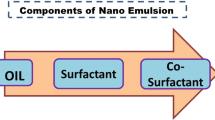Overview of Food Emulsifiers

Emulsifiers, also known as surfactants, are composed of amphiphilic molecules which act to form and stabilize colloids, emulsions, and foams. They act at interfaces between mutually insoluble phases. The hydrophilic region is attracted to the aqueous phase, while the non-polar group seeks the lipid or air phase. Solid emulsifiers can crystallize into a number of crystal structures known as polymorphic forms. When mixed with water, the molecules can aggregate into mesophases which may prove useful for controlling physical properties of some foods.
Emulsifiers are food additives regulated by government bodies such as the FDA and EEC. Other countries may have their own constraints on the types of emulsifiers used.
This is a preview of subscription content, log in via an institution to check access.
Access this chapter
Springer+ Basic
€32.70 /Month
- Get 10 units per month
- Download Article/Chapter or eBook
- 1 Unit = 1 Article or 1 Chapter
- Cancel anytime
Buy Now
Price includes VAT (France)
eBook EUR 234.33 Price includes VAT (France)
Hardcover Book EUR 295.39 Price includes VAT (France)
Tax calculation will be finalised at checkout
Purchases are for personal use only
Similar content being viewed by others

Emulsifying Properties
Chapter © 2021

Nanoemulsion ingredients and components
Article 17 December 2018

Naturally Derived Surfactants for Healthy Food Formulation
Chapter © 2023
References
- Becher P (2001) Emulsions: theory and practice (3rd edn). American Chemical Society, Washington, DC Google Scholar
- Federal Register (2013) Code of Federal Regulations, title 21, parts 170–1999. U. S. Government Printing Office, Washington, DC Google Scholar
- Israelachvili J (1992) Thermodynamic principles of self-assembly. In: Israelachvili J (ed) Intermolecular and surface forces. Academic Press, London Google Scholar
- McClements DJ (2004) Food emulsions: principles, practices, and techniques (2nd edn). CRC Press, London BookGoogle Scholar
- Phillips GO (2009) In: Williams PA (ed) Handbook of hydrocolloids (2nd edn). Woodhead Publishing, Boca Raton, FL ChapterGoogle Scholar
- Sjobiom J (2013) Emulsions: a fundamental and practical approach. Springer, New York Google Scholar
Author information
Authors and Affiliations
- Cheetahtech International, LLC, Port Saint Lucie, FL, USA Gerard L. Hasenhuettl
- Gerard L. Hasenhuettl


